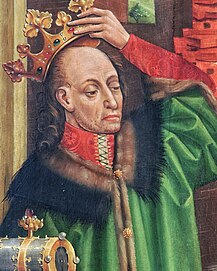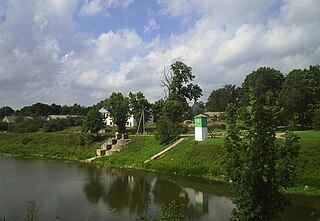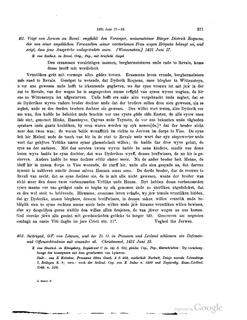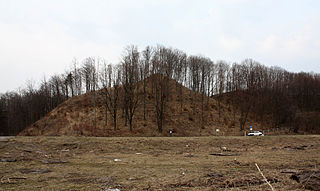
The Order of Brothers of the German House of Saint Mary in Jerusalem, commonly the Teutonic Order, is a Catholic religious order founded as a military order c. 1190 in Acre, Kingdom of Jerusalem.

Jogaila, later Władysław II Jagiełło was the Grand Duke of Lithuania (1377–1434) and then the King of Poland (1386–1434), first alongside his wife Jadwiga until 1399, and then sole King of Poland. He ruled in Lithuania from 1377. Born a pagan, in 1386 he converted to Catholicism and was baptized as Władysław in Kraków, married the young Queen Jadwiga, and was crowned King of Poland as Władysław II Jagiełło. In 1387 he converted Lithuania to Christianity. His own reign in Poland started in 1399, upon the death of Queen Jadwiga, and lasted a further thirty-five years and laid the foundation for the centuries-long Polish–Lithuanian union. He was a member of the Jagiellonian dynasty in Poland that bears his name and was previously also known as the Gediminid dynasty in the Grand Duchy of Lithuania. The dynasty ruled both states until 1572, and became one of the most influential dynasties in late medieval and early modern Central and Eastern Europe. During his reign, the Polish-Lithuanian state was the largest state in the Christian world.

Vytautas, also known as Vytautas the Great from the 15th century onwards, was a ruler of the Grand Duchy of Lithuania, which chiefly encompassed the Lithuanians and Ruthenians. He was also the Prince of Hrodna (1370–1382), Prince of Lutsk (1387–1389), and the postulated king of the Hussites.

The (First) Peace of Thorn was a peace treaty formally ending the Polish–Lithuanian–Teutonic War between allied Kingdom of Poland and Grand Duchy of Lithuania on one side, and the Teutonic Knights on the other. It was signed on 1 February 1411 in Thorn (Toruń), one of the southernmost cities of the Monastic State of the Teutonic Knights. In historiography, the treaty is often portrayed as a diplomatic failure of Poland–Lithuania as they failed to capitalize on the decisive defeat of the Knights in the Battle of Grunwald in June 1410. The Knights returned Dobrzyń Land which they captured from Poland during the war and made only temporary territorial concessions in Samogitia, which returned to Lithuania only for the lifetimes of Polish King Władysław Jagiełło and Lithuanian Grand Duke Vytautas. The Peace of Thorn was not stable. It took two other brief wars, the Hunger War in 1414 and Gollub War in 1422, to sign the Treaty of Melno that solved the territorial disputes. However, large war reparations were a significant financial burden on the Knights, causing internal unrest and economic decline. The Teutonic Knights never recovered their former might.

The Polish–Lithuanian–Teutonic War or Great War occurred between 1409 and 1411, pitting the allied Kingdom of Poland and Grand Duchy of Lithuania against the Teutonic Knights. Inspired by the local Samogitian uprising, the war began by Teutonic invasion of Poland in August 1409. As neither side was ready for a full-scale war, Wenceslaus IV of Bohemia brokered a nine-month truce. After the truce expired in June 1410, the military-religious monks were decisively defeated in the Battle of Grunwald (Tannenberg), one of the largest battles in medieval Europe. Most of the Teutonic leadership was killed or taken prisoner. While defeated, the Teutonic Knights withstood the siege on their capital in Marienburg (Malbork) and suffered only minimal territorial losses in the Peace of Thorn (1411). Territorial disputes lasted until the Peace of Melno of 1422. However, the Knights never recovered their former power and the financial burden of war reparations caused internal conflicts and economic decline in their lands. The war shifted the balance of power in Central Europe and marked the rise of the Polish–Lithuanian union as the dominant power in the region.

Seredžius is a town in Lithuania on the right bank of the Neman River near its confluence with the Dubysa River. According to the 2011 census, it had a population of 590.

Feldioara is a commune in Brașov County, Romania, about 15 kilometres from the city of Brașov. It is composed of three villages: Colonia Reconstrucția (Bohntelep), Feldioara and Rotbav.
Christmemel was a frontier fortress (Ordensburg) of the Teutonic Knights on the banks of the Neman River. It was constructed of wood and earth between April 8 and 22, 1313, by Grand Master Karl von Trier. Christmemel, manned by some 400 men, was to serve as a base for further attacks during the Lithuanian Crusade against pagan Samogitia and Grand Duchy of Lithuania.
Bayernburg is the name of three separate wooden castles of the Teutonic Order in different locations along the Neman River in the Grand Duchy of Lithuania during the Lithuanian Crusade. Their exact locations are not known and historians provide conflicting versions. The first fortress was built in 1337 by guest crusaders, including Henry XIV, Duke of Bavaria, in whose honor it was named after Bavaria. Emperor Louis IV declared it the capital of the to-be-conquered Lithuania. The newly built castle withstood a 22-day siege by Grand Duke Gediminas, but was abandoned by the Order in 1344. The Teutons burned down the first Bayernburg and built a brand new fortress a little closer to Prussia. The second Bayernburg withstood a six-day Lithuanian attack in 1381 but was burned down in July 1384 by Vytautas when he betrayed the Order at the conclusion of the Lithuanian Civil War (1381–84). The third Bayernburg was built in spring 1387 where Georgenburg stood but the new name did not gain acceptance and the fortress continued to be known as Georgenburg. This fortress was captured and burned down by Vytautas in April 1403 during the first Samogitian uprising.

Smalininkai is a small city in Lithuania. It is in the former Samogitian part of Memelland on the right bank of the Neman River, 12 km (7.5 mi) west from Jurbarkas. It was part of German East Prussia and was called Schmalleningken from 1422 to 1945. Between 1923 - 1939 and since the World War II it has been part of Lithuania.

The Battle of Durbe was a medieval battle fought near Durbe, 23 km (14 mi) east of Liepāja, in present-day Latvia during the Livonian Crusade. On 13 July 1260, the Samogitians soundly defeated the joint forces of the Teutonic Knights from Prussia and Livonian Order from Livonia. Some 150 knights were killed, including Livonian Master Burchard von Hornhausen and Prussian Land Marshal Henrik Botel. It was by far the largest defeat of the knights in the 13th century: in the second-largest, the Battle of Aizkraukle, 71 knights were killed. The battle inspired the Great Prussian Uprising and the rebellions of the Semigallians, the Couronians, and the Oeselians. The battle undid two decades of Livonian conquests and it took some thirty years for the Livonian Order to restore its control.

Stakliškės is a village in Lithuania, located east of Prienai, in Prienai district of Kaunas County on the Prienai-Trakai road. Stakliškės is a center of Stakliškės elderate. The famous type of Lithuanian mead, an alcoholic beverage distilled from grain, honey and water is produced in Stakliškės. According to the 2011 census, the village had 747 residents.

Betygala is a small town in Kaunas County in central Lithuania. As of 2011 it had a population of 488. In the 13th and 14th centuries the town had a noted Samogitan fortress, attacked by the Teutonic Knights numerous time. One of the first churches in Lithuania was built in the town. Mikalojus Daukša was the parish pastor from 1592 to 1603.

The Battle of Grunwald, First Battle of Tannenberg or Battle of Žalgiris, was fought on 15 July 1410 during the Polish–Lithuanian–Teutonic War. The alliance of the Kingdom of Poland and the Grand Duchy of Lithuania, led respectively by King Władysław II Jagiełło (Jogaila) and Grand Duke Vytautas, decisively defeated the German–Prussian Teutonic Knights, led by Grand Master Ulrich von Jungingen. Most of the Teutonic Knights' leadership were killed or taken prisoner. Although defeated, the Teutonic Knights withstood the siege of their fortress in Marienburg (Malbork) and suffered minimal territorial losses at the Peace of Thorn (1411) (Toruń), with other territorial disputes continuing until the Peace of Melno in 1422. The knights, however, would never recover their former power, and the financial burden of war reparations caused internal conflicts and an economic downturn in the lands under their control. The battle shifted the balance of power in Central and Eastern Europe and marked the rise of the Polish–Lithuanian union as the dominant political and military force in the region.

The Treaty of Christmemel was a treaty signed on 19 June 1431 between Paul von Rusdorf, Grand Master the Teutonic Knights, and Švitrigaila, Grand Duke of Lithuania. Švitrigaila was preparing for a war with Poland to defend his claim to the Lithuanian throne and sought allies. The treaty established an anti-Polish alliance and prompted the Knights to invade the Kingdom of Poland, starting the Polish–Teutonic War (1431–35). Lithuania also surrendered Palanga and three miles of the coastline on the Baltic Sea, thus modifying the Treaty of Melno of 1422.

Pieštvė was a wooden fortress of the Grand Duchy of Lithuania during the Lithuanian Crusade. It stood on a hill fort that is known as Palemon Hill in Seredžius, Jurbarkas District Municipality, Lithuania, located near the confluence of the Neman and Dubysa rivers. It was an important Lithuanian defensive outpost against the Teutonic Order. It was first mentioned in written sources in 1293 and attacked numerous times by the Order. Because it stood near Junigeda (Veliuona), both fortresses were often attacked together. It was burned down in 1363, a year following the fall of Kaunas Castle. It was rebuilt in May 1412 but lost its strategic importance after the Treaty of Melno (1422) and was abandoned. Earlier historians thought that Pieštvė was identical to Bisena.

Bisenė or Bisena was a wooden fortress of the Grand Duchy of Lithuania during the Lithuanian Crusade. It was one of the Lithuanian defensive outposts along the Neman River and was burned down by the Teutonic Order in 1283 and 1316. Its location was long debated and often confused with Pieštvė, but after 1985 research of Romas Batūra it has been generally accepted to be Kartupėnai Hill Fort near the confluence of the Kartupis and Neman in Jurbarkas District Municipality, Lithuania. After the burning down of Kolainiai in 1291 and Bisenė in 1316, Junigeda (Veliuona) became the western-most Lithuanian fortress along the Neman.
Mindaugas Sabutis is a Lithuanian prelate who is the current Primate of the Evangelical Lutheran Church in Lithuania.

























